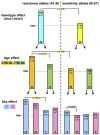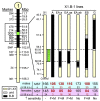Age and Sex of Mice Markedly Affect Survival Times Associated with Hyperoxic Acute Lung Injury
- PMID: 26103466
- PMCID: PMC4478006
- DOI: 10.1371/journal.pone.0130936
Age and Sex of Mice Markedly Affect Survival Times Associated with Hyperoxic Acute Lung Injury
Abstract
Mortality associated with acute lung injury (ALI) remains substantial, with recent estimates of 35-45% similar to those obtained decades ago. Although evidence for sex-related differences in ALI mortality remains equivocal, death rates differ markedly for age, with more than 3-fold increased mortality in older versus younger patients. Strains of mice also show large differences in ALI mortality. To tease out genetic factors affecting mortality, we established a mouse model of differential hyperoxic ALI (HALI) survival. Separate genetic analyses of backcross and F2 populations generated from sensitive C57BL/6J (B) and resistant 129X1/SvJ (X1) progenitor strains identified two quantitative trait loci (QTLs; Shali1 and Shali2) with strong, equal but opposite, within-strain effects on survival. Congenic lines confirmed these opposing QTL effects, but also retained the low penetrance seen in the 6-12 week X1 control strain. Sorting mice into distinct age groups revealed that 'age at exposure' inversely correlated with survival time and explained reduced penetrance of the resistance trait. While B mice were already sensitive by 6 weeks old, X1 mice maintained significant resistance up to 3-4 weeks longer. Reanalysis of F2 data gave analogous age-related findings, and also supported sex-specific linkage for Shali1 and Shali2. Importantly, we have demonstrated in congenic mice that these age effects on survival correspond with B alleles for Shali1 (6-week old mice more sensitive) and Shali2 (10-week old mice more resistant) placed on the X1 background. Further studies revealed significant sex-specific survival differences in subcongenics for both QTLs. Accounting for age and sex markedly improved penetrance of both QTLs, thereby reducing trait variability, refining Shali1 to <8.5Mb, and supporting several sub-QTLs within the Shali2 interval. Together, these congenics will allow age- and sex-specific studies to interrogate myriad subphenotypes affected during ALI development and progression and identify intermediary injury biomarkers that can predict outcome.
Conflict of interest statement
Figures






Similar articles
-
Synchronizing allelic effects of opposing quantitative trait loci confirmed a major epistatic interaction affecting acute lung injury survival in mice.PLoS One. 2012;7(5):e38177. doi: 10.1371/journal.pone.0038177. Epub 2012 May 29. PLoS One. 2012. PMID: 22666475 Free PMC article.
-
Reciprocal backcross mice confirm major loci linked to hyperoxic acute lung injury survival time.Physiol Genomics. 2009 Jul 9;38(2):158-68. doi: 10.1152/physiolgenomics.90392.2008. Epub 2009 May 5. Physiol Genomics. 2009. PMID: 19417010 Free PMC article.
-
Genetic analysis of hyperoxic acute lung injury survival in reciprocal intercross mice.Physiol Genomics. 2007 Aug 20;30(3):271-81. doi: 10.1152/physiolgenomics.00038.2007. Epub 2007 May 8. Physiol Genomics. 2007. PMID: 17488888
-
Renin-angiotensin system and its role in hyperoxic acute lung injury.Undersea Hyperb Med. 2016 May-Jun;43(3):239-46. Undersea Hyperb Med. 2016. PMID: 27416692 Review.
-
Congenic strains developed for alcohol- and drug-related phenotypes.Pharmacol Biochem Behav. 2000 Dec;67(4):671-81. doi: 10.1016/s0091-3057(00)00412-3. Pharmacol Biochem Behav. 2000. PMID: 11166057 Review.
Cited by
-
Lung injury-induced skeletal muscle wasting in aged mice is linked to alterations in long chain fatty acid metabolism.Metabolomics. 2016 Aug;12(8):134. doi: 10.1007/s11306-016-1079-5. Epub 2016 Jul 26. Metabolomics. 2016. PMID: 28217037 Free PMC article.
-
Heart disease in a mutant mouse model of spontaneous eosinophilic myocarditis maps to three loci.BMC Genomics. 2019 Oct 11;20(1):727. doi: 10.1186/s12864-019-6108-0. BMC Genomics. 2019. PMID: 31601172 Free PMC article.
-
Hyperoxia and Lungs: What We Have Learned From Animal Models.Front Med (Lausanne). 2021 Mar 9;8:606678. doi: 10.3389/fmed.2021.606678. eCollection 2021. Front Med (Lausanne). 2021. PMID: 33768102 Free PMC article. Review.
-
Clinical Predictors of Hospital Mortality Differ Between Direct and Indirect ARDS.Chest. 2017 Apr;151(4):755-763. doi: 10.1016/j.chest.2016.09.004. Epub 2016 Sep 20. Chest. 2017. PMID: 27663180 Free PMC article.
-
Transcriptomic-Metabolomic Profiling in Mouse Lung Tissues Reveals Sex- and Strain-Based Differences.Metabolites. 2022 Sep 30;12(10):932. doi: 10.3390/metabo12100932. Metabolites. 2022. PMID: 36295835 Free PMC article.
References
-
- Rubenfeld GD, Caldwell E, Peabody E, Weaver J, Martin DP, Neff M, et al. (2005) Incidence and outcomes of acute lung injury. N Engl J Med 353: 1685–1693. - PubMed
-
- Lewandowski K, Lewandowski M (2006) Epidemiology of ARDS. Minerva Anestesiol 72: 473–477. - PubMed
-
- Zilberberg MD, Epstein SK (1998) Acute lung injury in the medical ICU: comorbid conditions, age, etiology, and hospital outcome. Am J Respir Crit Care Med 157: 1159–1164. - PubMed
-
- Sloane PJ, Gee MH, Gottlieb JE, Albertine KH, Peters SP, Burns JR, et al. (1992) A multicenter registry of patients with acute respiratory distress syndrome. Physiology and outcome. Am Rev Respir Dis 146: 419–426. - PubMed
Publication types
MeSH terms
Grants and funding
LinkOut - more resources
Full Text Sources
Other Literature Sources
Molecular Biology Databases
Miscellaneous

